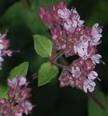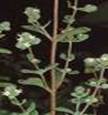Scientific Classification:
|
Other Common Names:
The other common names for the herb lovage are love parsley, sea parsley, lavose, liveche, smallage, European lovage, common lovage, Cornish lovage, English lovage, Italian lovage, maggi plant and old English lovage. History


Description


Range
Marjoram generally covers a range in gardens and also in pastures and the cornfields.
Sweet marjoram is often cultivated as a culinary herb which requires a dry, warm, well-drained soil, and at times prefers slightly alkaline conditions. The soil must be alkaline and rich on nutrients.
Cultivation
Seeds may be sown, for an early supply, in March, on a gentle hot-bed and again, in a warm position, in light soil, in the open ground during April. Germination usually takes place within 2 - 4 weeks. The seed is small and should be sown either in drills, 9 inches apart, or broadcast, on the surface, trodden, raked evenly and watered in dry weather. Prick out the seedlings into individual pots when they are large enough to handle and plant them out into their permanent positions in early summer. Care should be taken that the seedlings are not choked with weeds and if at all they should be removed by the hand, until the plants are large enough to use the small hoe with safety. Generally the larger divisions can be planted out direct into their permanent positions and the smaller divisions and grow them on in light shade in a cold frame until they are well established before planting them out in late spring or early summer. When about an inch high, thin out to 6 or 8 inches apart each way. It begins to flower in July, when it is cut for use, and obtains its name of Knotted Marjoram from the flowers being collected into roundish close heads like knots. The leaves are separated from the stems by being beaten with staves; they are discoloured by the sun, broken and mixed with the debris of stems of which the odour is less strong. Drying in the shade obtains more aromatic and less broken leaves, with less impurity.
Flowering Season
The herb marjoram is usually said to be in bloom in late summer.Pests and Diseases
Marjoram is mostly affected by Whitefly, spider mites and thrips. Whitefly parasites and mite predators are not effective on fast crops such as oregano. Thorough spot spraying with contact sprays at the earliest stages of pest infestation has given the best results. Mildew occurs when temperatures are low, air circulation is poor, and water is allowed to remain on leaves at night; but with care mildew is rarely a problem.Parts Used
Generally the whole herb especially the leaves are more of medicinal and commercial value.Medicinal Applications


- An excellent remedy for the brain.
- It is warming and comforting in cold diseases of the head, stomach, sinews and other parts taken inwardly or outwardly applied.
- Drinking the decoction helps diseases of the chest, obstructions of the liver and spleen, old griefs of the womb and windiness and loss of speech by resolution of the tongue.
- It is used to provoke women's courses.
- Made into a powder and mixed with honey it takes away the marks of blows and bruises.
- Oil of Marjoram is excellent as an application to bruises and sprains.
- The powder snuffed up into the nose provokes sneezing and thereby purges the brain.
- Marjoram is used as an external application for sprains, bruises, etc., and also as an emmenagogue.
- In powdered form the herb forms part of certain Sneezing Powders.
Commercial and Culinary Applications
- Leaves give strong spicy flavor for soups, sauces, stews, sausages, meatloaf, also good in potato salad.
- Rubbing with fresh leaves before roasting improves all strong meats.
- Adds special flavor to sausages and meatloaf.
- Marjoram is an extract for a relaxing bath and it acts as a hair strengthener.
- Oregano vinegar is to be used by for instance salads.
- An extract of the aromatic herb is used in preparing an aromatic tea.
Folklore and Myths
Marjoram is known as a culinary herb but it is also said to confer protection from harm, to enhance love in marriage, and to assuage grief and sorrow. Since it is claimed to give protection which in turn deflects bad luck when the leaves are placed in the rooms and place of buisness.The leaves must be replaced every month, they say, to retain their power. It is incorporated into charms and spells to draw love and fertility. It is rumored to help keep a married couple happily together. It is also said that a seven day bath in marjoram mixed with water helps a person relieving from his worries.


